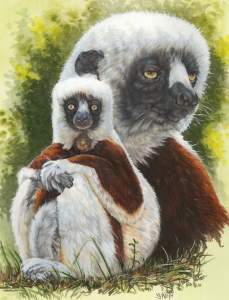Looking for design inspiration? Browse our curated collections!
About this Group
 There are no rules at this time - (except this does NOT include the human being) I just felt that the Primates (animals) were kind of left out so I fixed it!!
There are no rules at this time - (except this does NOT include the human being) I just felt that the Primates (animals) were kind of left out so I fixed it!!
A primate (/ˈpraɪmeɪt/ (About this soundlisten) PRY-mayt) (from Latin primat-, from primus: 'prime, first rank') is a eutherian mammal constituting the taxonomic order Primates. Primates arose 85–55 million years ago first from small terrestrial mammals, which adapted to living in the trees of tropical forests: many primate characteristics represent adaptations to life in this challenging environment, including large brains, visual acuity, color vision, altered shoulder girdle, and dextrous hands. Primates range in size from Madame Berthe's mouse lemur, which weighs 30 g (1 oz), to the eastern gorilla, weighing over 200 kg (440 lb). There are 190–448 species of living primates, depending on which classification is used. New primate species continue to be discovered: over 25 species were described in the first decade of the 2000s, and eleven since 2010.
Primates have large brains (relative to body size) compared to other mammals, as well as an increased reliance on visual acuity at the expense of the sense of smell, which is the dominant sensory system in most mammals. These features are more developed in monkeys and apes, and noticeably less so in lorises and lemurs. Some primates are trichromats, with three independent channels for conveying color information. Except for apes and humans, primates have tails. Most primates also have opposable thumbs. Many species are sexually dimorphic; differences may include muscle mass, fat distribution, pelvic width, canine tooth size, hair distribution, and coloration. Primates have slower rates of development than other similarly sized mammals, reach maturity later, and have longer lifespans. Depending on the species, adults may live in solitude, in mated pairs, or in groups of up to hundreds of members. Some primates, including gorillas, humans, and baboons, are primarily terrestrial rather than arboreal, but all species have adaptations for climbing trees. Arboreal locomotion techniques used include leaping from tree to tree and swinging between branches of trees (brachiation); terrestrial locomotion techniques include walking on two limbs (bipedalism) and modified walking on four limbs (knuckle-walking).
Primates are among the most social of animals, forming pairs or family groups, uni-male harems, and multi-male/multi-female groups. Non-human primates have at least four types of social systems, many defined by the amount of movement by adolescent females between groups. Most primate species remain at least partly arboreal: the exceptions are humans, some other great apes, and baboons, who left the trees for the ground and now inhabit every continent (Wikipedia).
Featured Images
Please Wait...